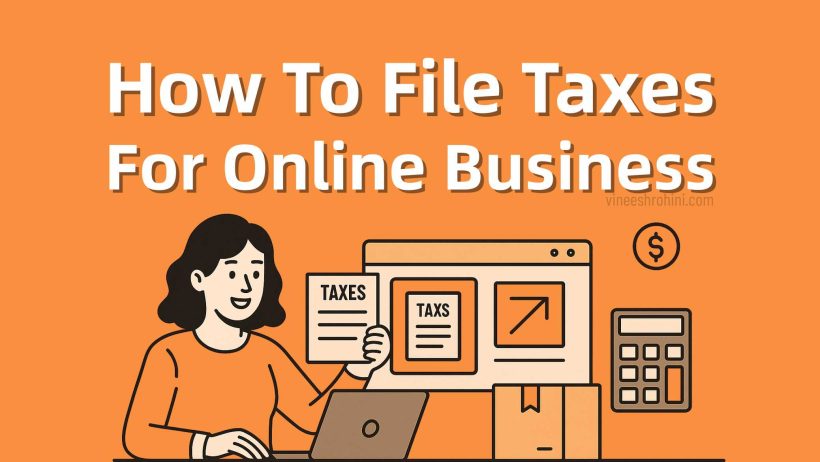How to File Taxes : In 2025, the Indian digital economy continues to thrive with millions of entrepreneurs, freelancers, and small business owners making a full-time or side income online. From selling digital products and affiliate marketing to freelancing, blogging, ecommerce, and dropshipping — the online business landscape is more diverse and accessible than ever. However, while the internet may make starting a business easier, filing taxes for your online income is something that must be done responsibly, legally, and in compliance with Indian tax laws.
Table of Contents
If you’re an online business owner in India — whether you’re a freelancer, YouTuber, seller on Amazon/Flipkart, creator on Instagram, or running your own Shopify store — this comprehensive blog will guide you step-by-step through how to file taxes for your online business in India in 2025.
Why Tax Filing Matters for Online Entrepreneurs

Taxes are not just for large corporations. If you’re earning money online in India, even as a side hustle, you are legally obligated to report your income and pay applicable taxes. Not doing so can lead to penalties, interest, and legal issues. Filing your income tax returns (ITR) not only keeps your business clean in the eyes of the government, but also helps with:
- Applying for business loans
- Obtaining GST registration
- Building credit history
- Participating in tenders or funding programs
- Visa processing and financial approvals
Understanding the Nature of Your Online Business Income
Before diving into tax filing, it’s important to identify how your income is categorized. Online business income in India generally falls under the following heads:
1. Income from Business or Profession
This is applicable if you are a freelancer, digital marketer, ecommerce seller, YouTuber, dropshipper, app developer, or running any business or service independently.
Also Read : How to Start a B2B Online Business ?
2. Income from Other Sources
This applies to income not directly connected to a profession or business, such as interest income or passive affiliate income if not regularly conducted.
3. Capital Gains
If you’re selling assets like domains, NFTs, or flipping websites/digital assets, profits can be taxed as capital gains.
Knowing your income type helps in selecting the right ITR form and calculating taxable income properly.
Step-by-Step Process to File Taxes for Online Business in India (2025)

Step 1: Calculate Your Total Gross Revenue
Start by calculating your total income earned from your online business, which includes:
- Payments from clients (domestic & foreign)
- Earnings from affiliate programs (Amazon, Impact, etc.)
- Google AdSense and YouTube revenue
- Sales from your ecommerce website or marketplaces
- Course sales, ebooks, and digital downloads
- Freelancing platforms (Upwork, Fiverr)
- App revenue or subscriptions
- Sponsored posts or collaborations
Maintain detailed records through tools like:
- Google Sheets / Excel
- Zoho Books / QuickBooks
- Razorpay, Instamojo, Payoneer, Stripe statements
Step 2: Deduct Allowable Business Expenses
Online business owners are eligible to deduct expenses directly related to their work before calculating tax. These can include:
- Website hosting/domain fees
- Software subscriptions (Canva, Notion, Adobe, etc.)
- Marketing and ad spend (Facebook Ads, Google Ads)
- Freelancer payouts
- Internet and phone bills
- Laptop depreciation
- Professional services (CA fees, legal advice)
- Rent for co-working spaces or office
- Travel expenses related to work
- Utility bills if you work from home (proportionate)
Note: Keep all invoices, receipts, and payment proof. These will help in case of scrutiny or audit.
Buy now : Ecommerce Website
Step 3: Choose the Right Tax Regime
India has two tax regimes:
- Old Regime: Includes deductions (80C, 80D, etc.) and slab-wise tax
- New Regime: Lower tax rates but no deductions
If your online business incurs lots of deductible expenses or you invest under tax-saving schemes, old regime may be beneficial. If not, opt for the new regime with flat rates.
Step 4: Register for GST (If Required)
GST (Goods and Services Tax) is applicable if:
- Your turnover exceeds ₹20 lakhs (₹10 lakhs in some special states)
- You sell goods/services interstate
- You sell on marketplaces (Amazon, Flipkart, Meesho, etc.)
- You run ads for clients or provide digital marketing services
GST Tax Rates for Online Businesses
- 18% on digital services (design, writing, marketing)
- 5-12% for physical products depending on category
- 0% for exports but with LUT (Letter of Undertaking)
If you’re eligible, file GSTR-1 and GSTR-3B monthly or quarterly. Failure to do so may result in penalties and late fees.
Step 5: Choose the Correct ITR Form
For online businesses, the common ITR forms are:
- ITR-3: For individuals/proprietors with income from business or profession.
- ITR-4 (Sugam): If you’re eligible for presumptive taxation under Section 44ADA or 44AD.
- ITR-5: For LLPs or partnership firms.
- ITR-6: For companies (Private Limited).
Step 6: Understand Presumptive Taxation (Section 44AD / 44ADA)
If your online business income is less than ₹2 crore (goods) or ₹50 lakh (services), and you don’t want to maintain detailed books, you can opt for presumptive taxation, where:
- You declare 6% of gross receipts as profit (if digital) under 44AD (goods).
- You declare 50% of gross receipts as profit under 44ADA (services).
This simplifies filing and record-keeping. But remember, if you opt out once, you can’t rejoin for 5 years.
Step 7: File Income Tax Return Online
- Visit incometax.gov.in
- Register/Login with PAN
- Choose e-File > Income Tax Return
- Select Assessment Year: 2025–26
- Choose appropriate ITR Form (ITR-3 or ITR-4)
- Enter income, deductions, taxes paid, and bank account
- Submit and e-verify via Aadhaar OTP or NetBanking
Due Dates:
- 31st July 2025: Individual/proprietor (non-audit)
- 31st October 2025: Audited businesses
- 30th November 2025: Transfer pricing or international dealings
Step 8: Advance Tax & TDS Consideration
Advance Tax:
If your tax liability exceeds ₹10,000/year, you must pay advance tax quarterly.
Due Dates:
- 15th June – 15%
- 15th September – 45%
- 15th December – 75%
- 15th March – 100%
TDS (Tax Deducted at Source):
Platforms like YouTube, Upwork, and affiliate networks may deduct TDS before payout. You can claim this while filing ITR using Form 26AS or AIS.
Step 9: Maintain Books of Accounts
As a business owner, you must maintain:
- Invoice books
- Expense records
- Profit and loss account
- GST filings (if applicable)
- Bank statements and payment proofs
- Asset register
Use software like Tally, QuickBooks, or Zoho for ease.
Step 10: Hire a CA or Use Tax Filing Platforms
While you can file taxes on your own, it’s advisable to consult a Chartered Accountant for:
- Audit requirements
- GST reconciliation
- Presumptive taxation advice
- Avoiding legal errors
Alternatively, use platforms like:
- Cleartax
- TaxBuddy
- Khatabook
- Quicko
- RazorpayX Tax Filing
Common Mistakes to Avoid in Online Business Tax Filing
- Ignoring GST registration despite crossing the threshold.
- Not declaring foreign income or freelance earnings.
- Mixing personal and business expenses.
- Not issuing invoices or collecting GST from clients.
- Late or non-payment of advance tax.
- Using wrong ITR form.
- Failing to reconcile TDS and Form 26AS.
- Forgetting to e-verify your return.
Benefits of Filing Taxes as an Online Business Owner

- Legal compliance and peace of mind
- Builds trust for collaborations or partnerships
- Access to government schemes and startup benefits
- Makes loan or funding applications easier
- Proof of income for personal finance, visa, and insurance
Tax Tips for Specific Online Businesses
For Freelancers:
- Register under 44ADA to simplify filing.
- Use platforms like Refrens to generate invoices and track payments.
For YouTubers & Influencers:
- Keep record of all sponsored post income.
- Include AdSense, affiliate, and merch revenue.
- Register for GST if providing services to brands.
For Ecommerce Sellers:
- Reconcile all invoices on marketplaces like Amazon.
- File monthly GST returns.
- Consider using GST-compliant invoicing tools.
For Bloggers & Affiliate Marketers:
- Declare affiliate commission as business income.
- Use income split by country to manage TDS and GST applicability.
Conclusion

Filing taxes for your online business in India is not just a legal obligation — it’s a step toward building a transparent, scalable, and professional enterprise. In 2025, the government is pushing for greater digitization and transparency. This means online business owners, creators, and freelancers need to stay tax compliant.
Buy now : Ecommerce Website
Whether you’re selling on Amazon, building a brand on YouTube, designing websites, or earning through affiliate marketing — this guide gives you the complete roadmap to manage your taxes with confidence. Start early, maintain records, understand the law, and seek expert help when needed.
Disclaimer: This article is for educational purposes only and does not constitute professional financial or tax advice. Please consult a licensed Chartered Accountant for personalized guidance.
Keywords : How to File Taxes – How to File Taxes in 2025








